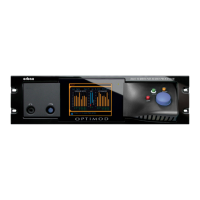OPTIMOD SURROUND PROCESSOR INTRODUCTION
1-17
under-indicates the true peak level by 8 to 14dB. The Peak Program Meter (PPM) in-
dicates a level between RMS and the actual peak. The PPM has an attack time of 5
or 10ms, slow enough to cause the meter to ignore narrow peaks and under-
indicate the true peak level by 5 dB or more. The absolute peak-sensing meter or
LED indicator shows the true peak level. It has an instantaneous attack time, and a
release time slow enough to allow the engineer to read the peak level easily. Figure
1-1 shows the relative dif
ference between the absolute peak level, and the indica-
tions of a VU meter and a PPM for a few seconds of music program.
Studio Line-up Levels and Headroom
The studio engineer is primarily concerned with calibrating the equipment to pro-
vide the required input level for proper operation of each device, and so that all de-
vices operate with the same input and output levels. This facilitates patching devices
in and out without recalibration.
For line-up, the studio engineer uses a calibration tone at a studio standard level,
commonly called line-up level, reference level, or operating level. Metering at the
studio is by a VU meter or PPM (Peak Program Meter). As discussed above, the VU or
PPM indication under-indicates the true peak level. Most modern studio audio de-
vices have an analog clipping level of no less than +21dBu, and often +24dBu or
more. So the studio standardizes on a maximum program indication on the meter
that is lower than the clipping level, so those peaks that the meter does not indicate
will not be clipped. Line-up level is usually at this same maximum meter indication.
In facilities that use VU meters, this level is usually at 0VU, which corresponds to the
studio standard level, typically +4 or +8dBu. If the link is PCM digital, there are two
common standards for line-up level: –18 dBfs (EBU) and –20 dBfs (SMPTE).
For facilities using +4dBu standard level, instantaneous peaks can reach +18dBu or
higher (particularly if the operator overdrives the console or desk). Older facilities
with +8dBu standard level and equipment that clips at +18 or +21dBu will experi-
ence noticeable clipping on some program material.
In facilities that use the BBC-standard PPM, maximum program level is usually PPM4
for music, PPM6 for speech. Line-up level is usually PPM4, which corresponds to
+4dBu. Instantaneous peaks will reach +17dBu or more on voice.
In facilities that use PPMs that indicate level directly in dBu, maximum program and
line-up level is often +6dBu. Instantaneous peaks will reach +11dBu or more.
Transmission Levels
The transmission engineer is primarily concerned with the peak level of a program
to prevent overloading or over-modulation of the transmission system. This peak
overload level is defined differently, system to system.
In FM modulation (FM/VHF radio and television broadcast, microwave or analog sat-
ellite links), it is the maximum-permitted RF carrier frequency deviation. In AM
modulation, it is negative carrier pinch-off. In analog telephone/post/PTT transmis-

